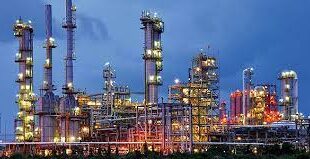The U.S. government wants to help build a petrochemical hub in Appalachia. one that could rival. or complement. the concentration of petrochemical facilities on the Gulf Coast.
The shale gas bonanza over the past decade has led to a tidal wave of cheap natural gas. which has resulted in shuttered coal-fired power plants. new gas-fired generation and even LNG export terminals. It has also led to a proliferation of pipelines. processing facilities and chemical complexes.
Much of the gas is coming from the Marcellus and Utica Shales. located in Pennsylvania. West Virginia and Ohio. While a lot of the gas is burned in the region for heating and electricity. the thousands of shale wells in the region are located far from the downstream facilities on the Gulf Coast that turn gas into plastics and fertilizers.
However. that is set to change. Royal Dutch Shell gave the greenlight to a massive $6 billion ethane cracker facility just outside of Pittsburgh. one of a slew of planned petrochemical facilities for the region. Taken together. the chemical and petrochemical boom could turn Appalachia into a new “hub“ of sorts of plastics and other petrochemical products.
The federal government is hoping to egg this on. The Department of Energy just published a report for the U.S. Congress trumpeting the case for a new petrochemical hub.
The early phase of the shale gas revolution. from the mid- to late-2000s. saw a surge in supply from the Barnett and Haynesville Shales. That led to the construction of a handful of ethane crackers on the Texas coast. The next phase of the shale gas drilling frenzy occurred from roughly 2010 or so onward. and it was concentrated in the Marcellus shale. Today. the Marcellus and Utica shales produce in excess of 30 billion cubic feet per day (Bcf d). by far the largest source of shale gas in the country.
Shale gas production is growing so quickly that the industry essentially needs more uses for their product. Much of the gas in the Appalachian region is “wet gas.“ which means that it comes with a relatively higher concentration of natural gas liquids such as ethane. All of that ethane can be a feedstock for plastics.
To date. a few companies have built pipelines to transport natural gas liquids to the Gulf Coast and to Canada. Nevertheless. ongoing increases in both natural gas (methane) and NGL production (ethane and other liquids) has meant that “the amount of ethane contained in raw natural gas production streams has exceeded domestic demand or the ability to export it abroad.“ the EIA wrote in a report earlier this year. “This situation has led producers to leave some of the ethane in the natural gas stream. up to allowable limits set by natural gas pipelines and distribution systems. and to sell it as natural gas. rather than recover and market ethane as a separate product.“
We are now entering the next chapter of this story. with major companies building downstream plants within Appalachia. potentially transforming the region into a new petrochemical hub. Just as Texas saw a wave of petrochemical investment in the early part of this decade following the spike in gas production in nearby Texas and Louisiana. the Appalachian region is in the midst of a petrochemical construction boom.
The U.S. Department of Energy forecasts that natural gas liquids will double between 2017 and 2050. “supported by an increase in global petrochemical industry demand.“ However. much of the growth is frontloaded – essentially between now and 2025. “[I]ncreased demand spurs higher ethane recovery and producers focus on natural gas liquids-rich plays. where NGL-to-gas ratios are highest.“ DOE is. of course. talking about the Marcellus and Utica shales in Western Pennsylvania. Eastern Ohio and parts of West Virginia.
There is likely to be environmental and public health problems associated with the petrochemical boom. which will also spur along even more shale drilling. Yet. the DOE’s remit in the report. as directed by Congress. was to only focus on the economic benefits. possible locations. infrastructure needs and energy security benefits. As such. the agency didn’t look at any of the downsides of the new Appalachian petrochemical hub.
“If the Appalachian region were its own country. it would be the third-largest gas producer in the world.“ Secretary of Energy Rick Perry said on Tuesday.
DOE advocated for a petrochemical hub in Appalachia as a way to diversify the downstream sector. which is currently heavily concentrated on the Gulf Coast. “The present-day geographic concentration along the Gulf Coast of petrochemical infrastructure and supply may pose a strategic risk. where severe weather events limit the availability of key feed stocks.“ the DOE report said.
When Shell’s new ethane cracker comes online in the early 2020s. it could supercharge shale gas drilling in the Marcellus and Utica shales. The region is already setting records for production. But a new wave of downstream facilities. which will soak up a lot of gas. could lead to even more drilling.
 Iran Energy News Oil, Gas, Petrochemical and Energy Field Specialized Channel
Iran Energy News Oil, Gas, Petrochemical and Energy Field Specialized Channel




